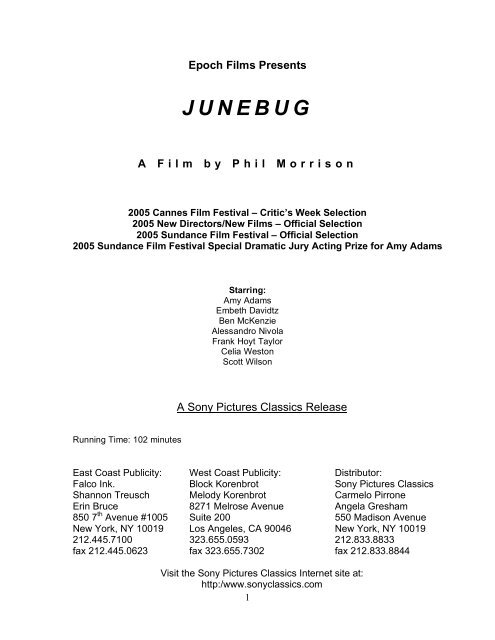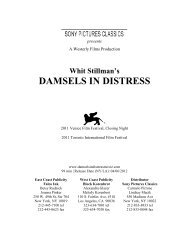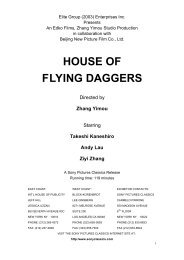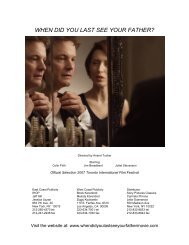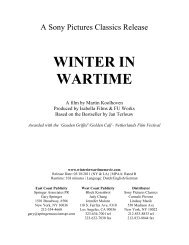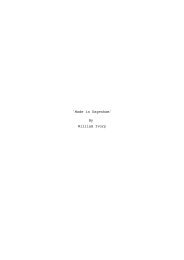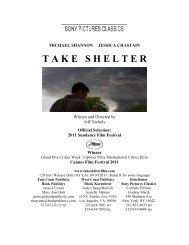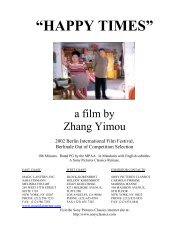JUNEBUG - Sony Pictures Classics
JUNEBUG - Sony Pictures Classics
JUNEBUG - Sony Pictures Classics
Create successful ePaper yourself
Turn your PDF publications into a flip-book with our unique Google optimized e-Paper software.
Epoch Films PresentsJ U N E B U GA F i l m b y P h i l M o r r i s o n2005 Cannes Film Festival – Critic’s Week Selection2005 New Directors/New Films – Official Selection2005 Sundance Film Festival – Official Selection2005 Sundance Film Festival Special Dramatic Jury Acting Prize for Amy AdamsStarring:Amy AdamsEmbeth DavidtzBen McKenzieAlessandro NivolaFrank Hoyt TaylorCelia WestonScott WilsonA <strong>Sony</strong> <strong>Pictures</strong> <strong>Classics</strong> ReleaseRunning Time: 102 minutesEast Coast Publicity: West Coast Publicity: Distributor:Falco Ink. Block Korenbrot <strong>Sony</strong> <strong>Pictures</strong> <strong>Classics</strong>Shannon Treusch Melody Korenbrot Carmelo PirroneErin Bruce 8271 Melrose Avenue Angela Gresham850 7 th Avenue #1005 Suite 200 550 Madison AvenueNew York, NY 10019 Los Angeles, CA 90046 New York, NY 10019212.445.7100 323.655.0593 212.833.8833fax 212.445.0623 fax 323.655.7302 fax 212.833.8844Visit the <strong>Sony</strong> <strong>Pictures</strong> <strong>Classics</strong> Internet site at:http:/www.sonyclassics.com1
Epoch Films PresentsJ U N E B U GAmy AdamsEmbeth DavidtzBen McKenzieAlessandro NivolaFrank Hoyt TaylorCelia WestonScott WilsonCasting byMark Bennett, C.S.A.Original Music byYo La TengoCostume DesignerDanielle KaysEditorJoe KlotzProduction DesignerDavid DoernbergDirector of PhotographyPeter DonahueExecutive ProducersMark P. CleinEthan D. LederDaniel RappaportDany WolfProduced byMindy GoldbergMike S. RyanWritten byAngus MacLachlanDirected byPhil Morrison2
J U N E B U GSynopsisWhen Madeleine (Embeth Davidtz), a British-born dealer in regional, “outsider” art,travels from Chicago to North Carolina to pursue a local painter for her gallery, she andher brand-new, younger husband George (Alessandro Nivola) extend the trip toinclude an introduction to his family: his prickly mother Peg (Celia Weston); his taciturnfather Eugene (Scott Wilson); his angry younger brother Johnny (BenjaminMcKenzie), who has always suffered in the shadow of his over-achieving brother; andJohnny’s very pregnant and innocently garrulous wife Ashley (Amy Adams).Although Ashley immediately takes to the sophisticated Madeleine and embraces her asa sister, the other members of George’s family, especially his mother, are less thanreceptive. With George falling into his old routine of spending time alone, Madeleinerelies almost entirely on Ashley to help her navigate the family dinners, Churchmeetings and Ashley’s baby shower, all while desperately trying to close the deal on theartist. Tensions mount when Ashley goes into labor and each family member’spriorities, Madeleine’s included, are confronted.3
J U N E B U GDirector’s StatementI’ve never that feeling of “this story must be told.” That’s sort of a prose-basedinspiration, I guess, and thank God people have it. I’ve been inspired more bymoments, or by phenomena, in movies. It makes sense to me that some movies arecalled transcendental. Just a couple transcendent moments are enough to make amovie worthwhile to me; and if there are more, and they work together in somemysterious way to create the moral-mystical-delirious experience that’s unique tomovies, then I’m inspired. So I’m inspired by an obvious list of great directors: Demy,Demme, Davies, Minnelli, Cukor, Burnett, Imamura, Kiarostami, Bresson, Sturges, N.Ray, Ozu, Renoir, Leigh, Spielberg, Zhang, Makhmalbaf. It seems like a good idea tolook to them for guidance.So Angus’ script for “Junebug” was appealing to me primarily because I could seeopportunites to attempt those moments. And hopefully those moments converge tobecome something worthwhile. Not a something we planned in advance, but analchemical something that’s an unforeseen result or our planning in advance.The people in the opening shots are hollering. This was once a practical form ofcommunication in the North Carolina hills. I think it’s an appropriate start for this moviein two ways. First, “Junebug” is about people communicating across great divides.Second, I’m interested in the moral challenges posed by the relationship betweenmakers and connoisseurs. Hollering is still practiced because it has been recognized asan art form and incorporated into a “folk tradition.” It has been aestheticized by itsappreciators, who have become its patrons and, often, its practitioners. “Junebug” ismeant to explore the difficulty created by relationships based on patronage, howeverwell meaning.For instance, one idea that arose is that such relationships glorify the peculiar, andconvince us to view what is common as “cliché.” It was not at all my intention to avoidclichés, but rather to try to explore what it is about a particular thought, object, phrase,etc, that so raises my hackles that I declare it “clichés.”Maybe the ultimate verity that “Junebug” clings to is that darkness and light areinseparable. We go to great lengths to deny it in order to feel safe, and are shakenwhen this denial falls apart. Certainly there’s nothing new in this, but I guess that’s thepoint.-- Phil Morrison4
exploration of, what is actually “common” (good things, and evil too). I don’tsuggest this is particular to the South, but that’s where we were thinking about it.MacLachlan: There was a lot of discussion about whether we could afford tofilm in NC and Phil felt very strongly that it was important to the project. Thecharacters, the house, the land, the story was very specific in time and place.Although the cast had three southerners (Celia, Scott, and Ben) all of the actorsgot to spend time here, encounter the extras, the town, and the weather. Sinceboth Phil and I are natives we know the people we were trying to portray. Weknow those kitchens, those church suppers. The basic story of someone comingfrom the outside could, I suppose, be set anywhere, but this family with thisdynamic and socio-economic make-up lives in a specific neighborhood in thetown we both know. The delicate line of of non-denigrating humor and truefeeling and depth that I was aiming for in the script and Phil illuminated in the filmmay be specifically southern, may be North Carolinian, I don't really know. But forthis story it was very important to be true to the people I live with.Q: Briefly explain the relationship between George and his family? Whatmakes him different? Why would anyone in his family have reason toresent him?Morrison: Cosmopolitan country music has lyrics about rambling, hitting theroad, etc. But nearer the mountains you get songs like “No Desire to Roam” and“I Long To See the Old Folks.” To be in the family is to stay near. George’sdesire to be gone is a betrayal. That desire was probably evident since he was akid, and the family flattered him and wooed him to stay. But he still left.MacLachlan: I believe George is the Golden Boy. The first born who alwaysshown bright, always succeeded, always glowed. He has what the Italians call"The Seven Beauties". People have always been drawn to him and his smile.Consequently they project what they imagine their idea of "A Star" is on Georgeand very few actually know him. I think he is troubled because he realizes he isnot perfect. He is not what people see. He got out, by his charm, his talents, andhas "succeeded" in the larger world. And he wants to stay away.Q: Turning specifically to George’s brother Johnny, the one family memberthat has experienced the most change since George left home, what is theroot of his anger toward George?Morrison: There might be an idea in the family that if George wanted to, hecould have Johnny’s life. But Johnny could never be George. (And toward theend of the movie, George takes it upon himself to, in a way, stand-in for Johnnyat an important time). This is enough to make Johnny feel that George is anobliterating presence, or at least an asshole.6
MacLachlan: Johnny is a grown man living back in his old bedroom in hisparents house with his pregnant wife, attempting to get his high school diplomaby studying for his GED. He has never been the favored son, and he currentlyfeels like a failure, so the arrival of the Golden Boy and his beautiful new wifethrow all his perceived weakness in deep relief. At the same time he seesthrough his brother's p.r. He knows George isn't perfect, isn't what his mother, hiswife, his pastor declare him to be, and, he feels, no one else sees this or willacknowledge it.Q: Madeleine is an outsider to this Southern family and there is anintentional metaphor in the story that parallels the sought after “outsider”artwork and artist as something special and valuable. How does thismetaphor relate to the story and this family’s ability to accept an outsiderlike Madeleine into their family?MacLachlan: Sometimes distance and perspective allows one to appreciatesomething. Sometimes it means one can not really know the thing beingperceived. This dichotomy is one of the touchstones of the story. Madeleine saysshe has "loved the South" since she was a child living all over the world, and feltan affinity to it. This draws her to the art and culture. But she is challenged whenshe becomes entangled in trying to get to know, and help, Johnny when he tellsher she's no better than they are. Is a certain superiority inherent in her, and our,love of 'folk art'? And at the end of the film, has she come to an emotional placefeeling, indeed, she is not any better than they are, while her husband may stillfeel that yes, he is?Q: Ashley, the newest member of the family, is the only one determined tomake Madeleine feel welcome. Explain why you chose this character to bethe most dynamic? Why is it so important to her that Madeleine isaccepted by George’s family? What does she stand to gain or learn fromMadeleine?MacLachlan: I think for Ashley, Madeleine is everything she dreams a womanshould be, albeit a little more eye shadow would help. She is beautiful, thin,smart, kind, cultured, successful, continental, and speaks beautifully. She hasGeorge, the icon. Ashley truly loves George, and immediately loves Madeleine.For her, she now has a new sister. If the masks were to slip and Ashley were tobe able to see the weakness and darkness that exist in Madeleine and George,she would still love them, it would not change anything for her. Ashley's heart ismighty and courageous. It may blaze forth naively, but it is still true.I think that Eugene, in his almost silent way, accepts and welcomes Madeleineas well. Of anyone he sees the members of his family clearly, and, like Ashley,accepts them for who they are. He may perceive the match between George and7
Madeleine even better than they do themselves. Perhaps intimidated at timesinto silence by Madeleine, he still loves her as part of his family.Q: George does not appear to be an insensitive character yet seems to bethe least concerned with his family’s “cold shoulder” attitude towardMadeleine. Do you think George would have visited his family at all if ithadn’t been for Madeleine’s art scouting trip?MacLachlan: I believe George would not have come back if Madeleine had notneeded to see the Artist. He would have found more excuses to stay away. It hasbeen three years since the last time he was home, and maybe only a family crisisor illness would get him to return, if it wasn't for Madeleine.ABOUT THE PRODUCTIONQ: What is the history of the project and your collaboration? Did Angusbring the script to you when finished or did you collaborate on thescreenplay along the way?Morrison: Angus has always been a hero of mine. When I was in college, weadapted part of his play “Behold, Zebulon” into my junior project “Tater Tomater,”a 20-minute short. The short was in Sundance in 1992. It took a long time to beable to make a feature. Angus wrote “Junebug,” and then we worked together onit off and on for a long time, while trying to figure out how people actually find themoney to make movies. (It was hard to figure out what to call it. At one pointAngus called it “Divertimento,” which I think connects to the answer above. Atanother point we called it “Look Away, Look Away, Look Away,” in reference to“Dixie.”) I showed the script to Mindy Goldberg and she believed in it and startedto help. And it still took a long, long time. Meanwhile, we did other things too.Angus’ play “The Dead Eye Boy” was produced in New York and I directed“Upright Citizens Brigade” for Comedy Central. Certainly, the movie would bevery different if we’d made it when we first started thinking about it.8
Q: How did you end up teaming with these producers?Morrison: I’ve known Mindy Goldberg a long time. We’ve worked togethermaking music videos and commercials at her company, Epoch Films. I had noidea if she’d be interested in trying to make a movie, but I knew she’d be great atit. And she seemed to see in Angus’s script the same things I did. So we agreedto try to make Epoch’s first movie, and keep it small. Angus and I had beentrying to get “Junebug” made for a while, but it only became a real movie whenMindy got involved.Mike Ryan, fresh off “Palindromes” and “40 Shades of Blue,” agreed to join usand show us the ropes. He was excellent at reminding me when I strayed fromour Ozu-derived principles (which was often).Q: Describe the casting process for this film?Morrison: Celia Weston went to Salem College in Winston-Salem, and Angushas known her a long time. She agreed to be Peg early on (which blew my mindand gave me hope). She was very loyal to our struggle. For a few years, shewould call to check our progress before agreeing to be in some huge movie. Itfelt funny to say, “No Celia, it doesn’t look like we’re quite ready to get started, soyou can go do ‘The Hulk.’”In my first meeting with Mark Bennett, our casting director, I started to talk aboutthe character Ashley. He said “There are a lot of good people for that part, but,mark my words, it’s going to be Amy Adams.” And sure enough there were a lotof good people, but no other Amy. During her audition, it struck me that she wasreally teaching me about the movie. Not just her character, but the whole movie.That continued until the day she wrapped. While we were in Winston-Salem, wewent to Green St. Methodist Church. One Sunday the minister said “God lovesyou just the way you are, but too much to let you stay that way.” There was noway were were going to let the shoot end without Ashley repeating that.I hadn’t seen “The O.C., “ so when Ben McKenzie read for Johnny, hisTexas/Virginia essence was unmitigated. When we were doing the scene whereJohnny tries to tape the television show about meerkats, I had to stop theaudition and pounce on him at one point because he was about to destroysomeone else’s audition tape. I’m confident he was in character and it was not aploy to diminish someone’s chances.I knew we were in good shape with our Ben/Johnny transformation when Bencould walk around the stock car races at Bowman Gray Stadium and not getrecognized (and I don’t think it was just his mustache).Watching Scott Wilson’s harrowing performance in “Monster,” it occurred to mehe would be a great Eugene. I hadn’t seen “In Cold Blood” in quite some time. I9
think it’s funny that my experience of Scott was bookended by these horriblemurders, and yet he seemed so perfect to be the gentle character of Eugene.I also think it’s funny that when we cast Alessandro Nivola as George, so manypeople said, “Oh it’s interesting that you’re having an English guy play that part.”Our shooting schedule got a little screwy so Alessandro had many days freebefore we ever got around to shooting him. He was very patient. At one point hedrove four hours to watch Italians play soccer via satellite. I hooked him up witha nice family in town so he could go to their house during the day and watchmatches on pay-per-view. (His accommodations did not have such frills). I thinkhe had his own key to their house. I’d like to believe he would’ve stayed in themovie even if we hadn’t made this arrangement.The aforementioned screwy schedule required Embeth Davidtz to spend her firstday half-naked and her second in the strange, difficult book report scene. Iknew from our meetings that she had Madeleine’s beauty and grace and that shehad her own clear understanding of the character’s inner life. But I almost gotteary when she arrived in Winston-Salem and I saw her script. I have no ideahow, in the short time she had the script, she managed to get it so dog-eared andfill up every margin with notes.Frank Hoyt Taylor almost never let me see him out of character, which wasinspiring and unnerving (and therefore appropriate to his part). The dialect Frankuses for David Wark is very particular to a part of northwest North Carolinabetween where I grew up and where Frank lives at the Virginia border. Wark’saccent is particularly inspired by N.C. storyteller Ray Hicks.I saw Joanne Pankow in “Love Liza” and thought she’d be perfect to play DavidWark’s sister. Little did I know she’d be in two other movies in competition atSundance this year (“Loggerheads” and “40 Shades of Blue”).Q: How many locations and shooting days did it take to make this film?Where was the film shot and why did you choose this/these locations?Morrison: We had 20 shoot days. We shot mostly in Winston-Salem, N.C. andnear Pilot Mountain, N.C. Both Angus and I were born and raised in Winston-Salem. Angus lives there with his wife and daughter. At the beginning of themovie, George says he’s from Pfafftown, which is nearby. Many people thinkhe’s saying “Pufftown.” I guess we should have thought of that. Pilot Mountain,incidentally, is the “Mount Pilot” often referenced on the “Andy Griffith Show.” It’sjust down the road from Mt. Airy, which was the model for Mayberry. You cansee it in one shot toward the end of “Junebug.” I’m happy for the movie to payits respects to the “Andy Griffith Show. “ I don’t think anyone has better capturedwestern N.C. than the people who made that show. And while their geniusenabled them to do it on a back lot in Hollywood, I wasn’t ready to try anythinglike that. We didn’t have much time or money, so there was talk of saving both10
y shooting near New York. But that was too scary. I didn’t have the confidenceto fake it. I didn’t want to assert my memory of home, but for the environment toassert itself.Our dauntless location scout, Corey Walter, found a perfect neighborhood inWinston-Salem. Most of the houses were empty because before too long the citywill be expanding the nearby landfill. So for a couple weeks we had a back lotafter all, right there in Piedmont North Carolina. The landfill crew were ourfriends and liaisons. It was tranquil and a couple days before we startedshooting, all the lawns were covered with junebugs. You can see them flying insome shots. That location may have been the greatest fortune our movie had.Q: What equipment did you use to shoot the film?Morrison: Peter Donahue (Director of Photography) shot Super 16mm film fromKodak with an Arriflex SR3 camera and an Aaton A-Minima (for inside the car).Joe Klotz (Editor) cut the movie on an Avid System.We finished the movie as a digital intermediate at Version 2 and Technicolor,both in New York.11
ABOUT THE CASTAmy Adams (Ashley) first garnered attention in Steven Spielberg’s smash hitCATCH ME IF YOU CAN, in which she played Leonardo DiCaprio’s adoringfiancée, ‘Brenda.’Her other film credits include DROP DEAD GORGEOUS, PSYCHO BEACHPARTY, CRUEL INTENTIONS 2, THE SLAUGHTER RULE, PUMPKIN andSERVING SARA. Amy has also appeared on numerous television shows suchas That ‘70s Show; Charmed; Zoe, Duncan, Jack and Jane; Providence; Buffy,the Vampire Slayer; Smallville; and The West Wing.Amy finished shooting the following films,THE LAST RUN and STANDINGSTILL, and was last seen in THE WEDDING DATE opposite Debra Messing.Embeth Davidtz (Madeleine) has consistently delivered compellingperformances since her breakout role as the doomed Jewish maid in StevenSpielberg’s SCHINDLER’S LIST. Time and again, she has wrought luminous,intelligent portrayals alongside some of Hollywood’s most talented actors.Embeth co-starred in BRIDGET JONES’ DIARYwith Renee Zellwegger, ColinFirth, and Hugh Grant. She also appeared in Universal <strong>Pictures</strong>’ THEEMPEROR’S CLUB, directed by Neil Tolkin and co-starring Kevin Kline. Filmcredits include MANSFIELD PARK, Robert Altman’s critically acclaimed thrillerTHE GINGERBREAD MAN, and FEAST OF JULY. Embeth also appeared inMATILDA, FALLEN opposite Denzel Washington, and MURDER IN THE FIRSTopposite Kevin Bacon.Ben McKenzie (Johnny) was born and raised in Texas. Following, hisgraduation from the University of Virginia where he was a Foreign Affairs andEconomics Major, he moved to New York to pursue acting.While in New York he appeared off-Broadway in "Life is a Dream" at the SohoRep. Additionally, he performed in numerous productions at the WilliamstownTheatre Festival, including "Street Scene" and "The Blue Bird," and at theUniversity of Virginia, in "Measure for Measure" and "Zoo Story" before moving toLos Angeles where he landed the lead role in the Fox series “The O.C.”Alessandro Nivola (George) was recently seen in the Pieter Jan Brugge filmTHE CLEARING, starring Robert Redford, Helen Mirren and Willem Dafoe. Inaddition to <strong>JUNEBUG</strong>, he recently wrapped the following independent features:THE SISTERS, opposite Maria Bello, Elizabeth Banks and Erika Christenson;and TURNING GREEN, starring opposite Timothy Hutton. Alessandro was last12
seen in LAUREL CANYON, directed by Lisa Cholodenko (HIGH ART), starringopposite Frances McDormand, Christian Bale and Kate Beckinsale.Celia Weston (Peg), a sensational character actress born and raised in SouthCarolina, has played many a tough Southern gal despite her theater training inboth London and New York. Working both on and off Broadway in the '70s, shemoved over to television as the snappy Mel's Diner waitress Jolene Hunnicut onthe CBS sitcom “Alice.” After that, she appeared in Southern-tinged feature filmslike HONKY TONK FREEWAY and STARS AND BARS. Also adept at playingmatronly types, she played the mother of Beastie Boy Adam Horowitz in LOSTANGELS, the mother of one of the victims in Dead Man Walking, and thesupposed mother of Ben Stiller in FLIRTING WITH DISASTER. Back on thestage in 1997, she earned a Tony nomination for her role as Southern Jew RebaFreitag in Alfred Uhry's Last Night at Ballyhoo and returned to Broadway in 2000as Mom in the revival of Sam shepard’s True West. She made a comeback tofilms as well with supporting roles in Ride With the Devil, THE TALENTED MR.RIPLEY, and SNOW FALLING ON CEDARS. In 2001, she played a Southernbelle mental patient in K-PAX followed by the gossip-hound Mona in FAR FROMHEAVEN, the Fowler's family friend in IN THE BEDROOM, and the guardian ofteenaged Bruce Banner in THE HULK. In 2003 she was back to the small screenas a cast member on the Showtime original series Out of Order.Scott Wilson (Eugene) was born in 1942 in Altanta, Georgia U.S.A.Wilson graduated from Thomas High School and was awarded a basketballscholarship at Georgia’s Southern Tech University to study architecture.Becoming an Architect was more of his father’s idea than his and so when aninjury forced him to leave College, Wilson (19) hitchhiked across the country toLos Angeles, seeing a good bit of "local colour" on the way.Wilson fell into acting, literally, falling down drunk and landing in an acting classwith a newfound pal who announced "here’s a star". The next day, feeling veryembarrassed about his condition, he returned to the class to apologise. Theacting teacher gave him the monologue from LONG DAY’S JOURNEY INTONIGHT to read and he became intrigued and stayed on in the class, later beingcast in THE IMPORTANCE OF BEING EARNEST his first playWilson made his motion picture debut in a supporting role of Director NormanJewison’s IN THE HEAT OF THE NIGHT starring Rod Steiger. His second breakthroughfilm was IN COLD BLOOD in which he played his first leading role, asreal life murderer Dick Hickok. This movie was based on Truman Capote’sfamous book of two wandering gunmen (Robert Blake played the other real lifemurderer Perry Smith) who slaughter an entire, innocent mid western family afterrobbing their house.One of Wilson’s memorable roles was as the garage owner in GREAT GATSBY,13
who shoots Gatsby (Robert Redford) dead in his swimming pool at the end of themovie and GRISSOM GANG,directed by Robert Aldrich in which Wilsonplays lecherous psychopath Slim Grissom.One of his more intriguing credits was with the first US-Polish film YEAR OF THEQUIET SUN, in which he played the romantic lead of an American GI whodoesn’t speak Polish and a Polish woman who doesn’t speak English. This filmwon the Golden Lion Award at the Venice Film Festival and got great reviews inthe United States.A film that Wilson is most proud of is OUR GOD’S BROTHER in which heportrayed Adam Chmielowski (Saint Brother Albert), based on a story written byKarol Wojtyla (Pope John Paul II) before he became the Pontiff. The filming ofthis movie took Wilson and his Wife, Heavenly, an attorney and also aprofessional painter and sculptor who he met in 1974 after filming GREATGATSBY to Rome, Italy where they personally met the Pontiff.His other feature film roles include Sydney Pollack’s CASTLE KEEP starring BurtLancaster, Richard Fleisher’s NEW CENTURIONS, starring George C. Scott andON THE LINE a US-Spanish co-production for which he was Best Actor cowinnerat the Cartagena Film Festival.Some of Wilson’s more recent and dramatic movies have included JOHNNYHANDSOME starring Mickey Rourke, YOUNG GUNS II starring Lou diamondphillips and Emilio Estevez, GERONIMO: AN AMERICAN LEGEND starringGene Hackman, FLESH and BONE starring Dennis Quaid, Tim Robbins’ DEADMAN WALKING starring Sean Penn, JUDGE DREDD starring Sylvester Stalloneand G.I. JANE starring Demi Moore.Also in 1997 Wilson was remembered by Rod Steiger for his considerable talentIN the HEAT OF THE NIGHT and felt that he would be perfect to play JuddTravers in the family film SHILOH. This is a story about a courageous boy, whothrough compassion, touches the heart of a man filled with hate (Wilson).Then in 1999 SHILOH 2: SHILOH SEASON (1999) was made with Wilson againappearing as Judd Travers, who by the end of the movie has found that throughthe power of kindness, he could learn not to hate.Most recently, Wilson was seen a very memorable Joe in the Oscar-winning filmMONSTER starring Charlize Theron and as Ambassador Swanbeck in the epicEd Zwick feature THE LAST SAMURAI with Tom Cruise.14
ABOUT THE FILMMAKERSPhil Morrison (Director) was born in Winston-Salem, North Carolina in 1968.His NYU student film, "Tater Tomater," written by Angus MacLachlan, wasfeatured at the Sundance Film Festival and on American Playhouse. It isdistributed by First Run Features and was one of very few shorts to be selectedby the Museum of Modern Art for its First Run retrospective in May, 2001.He was Consulting Producer and Director of several episodes of the highlyregarded series "Upright Citizens Brigade" for Comedy Central.Other work includes an episode of "The Adventures of Pete and Pete" forNickelodeon and a long-form Godard homage for X-Girl Clothing, starring ChloeSevigny.He has directed many TV commercials. His music videos include clips for SonicYouth, Yo La Tengo, Superchunk, The Feelies, Lemonheads, Rocket from theCrypt and Juliana Hatfield.Angus MacLachlan (Writer) graduated from the North Carolina School of theArts Drama School.His play THE DEAD EYE BOY was selected as the 2000 Lois and RichardRosenthal New Play Prize Award Winner and premiered by Cincinnati Playhousein the Park. It was a finalist for the Steinberg New Play Prize, presented by theAmerican Theater Critics Association. His play BRIDGE won the 2000 NewWorks prize presented by Actor’s Theatre of Santa Rosa. In 2001 theWilliamstown Theatre Festival nominated Angus for the Kesselring Prize.THE DEAD EYE BOY, starring Lili Taylor, opened in NY at the Manhattan ClassCompany in April, 2001. It was nominated for two Drama Desk Awards. InJanuary of 2002 it opened in London at the Hampstead Theatre, starring OlivierAward winner Brendan Coyle. It is being published by Dramatists Play Service.An 18 minute short film he wrote, TATER TOMATER, was directed by PhilMorrison and aired on American Playhouse, and screened at the ’92 SundanceFilm Festival. In May of 2001 it was seen at the Museum of Modern Art, in FirstRun Features “Best of 25 Years” retrospective.Among the plays he has written are DIVERTIMENTO, which was produced atThe Wonderhorse Theatre off-off Broadway, ARIADNE DUVALL, produced atCircle Rep., and BEHOLD, ZEBULON which was selected as Best Play of theYear by Winston-Salem Magazine. He has also written and performed 3 one manshows - BOUND AND GAGGED, BUENA VISTA , and MARGINAL LIVING which15
was then filmed and shown on NC Public TV and on KTEH San Jose Public TV’s“video i” series.Other plays include TEX’S DREAM, WILLY-NILLY, CATTYCORNERED, andBRIDGE. Among his screenplays are VETVILLE, CRISIS CONTROL, andCIRCUS BIM BAM. His screenplay <strong>JUNEBUG</strong> is currently in productions withEpoch Films.Among his grants have been an Emerging Artist Fellowship from the Winston-Salem Arts Council, a Semans Grant, a N.C. Humanities Council Award, andAppalshop-the Southeast Media Fellowship Award.STAY was selected for the 2002 A.S.K. Literary Projects’ Writers Retreat in LosAngeles.In 2002 he was commissioned by Woolly Mammoth Theatre in Washington, D.C.The play, 'THE RADIANT ABYSS' premiered at the Kennedy Center in June2004.Mindy Goldberg (Producer) began her career in commercial production in 1980at Adrian Lyne’s commercial production company, Jennie & Co. During her nineyeartenure she produced commercials for a group of established English andAmerican directors, including Adrian Lyne, Terry Bedford, Rocky Morton &Annabel Jankel and Bruce Dowad. As executive producer, she doubled theannual billings within 2 years.In 1989 Goldberg founded Epoch Films conceived to provide opportunities totalented young directors who otherwise would not have access to the commercialmainstream.In the last 13 years, Epoch has established itself as a leading commercialproduction company, with a notable directorial roster. Epoch’s work strives tomake lasting statements that break the standard form and set new styles.Epoch Films has production offices in New York City, Los Angeles and London.Mike S. Ryan (Producer) has been working in the Ny film industry for 14 years.He has location managed films for ang lee, todd haynes, roland enerich, jimbrooks and many others.He has been producing low budget features for the past two years. He is theproducer of the new todd solondz film “palindromes” which will premiere at thevenice film festival this fall.16
Mike is a graduate of NYU graduate school and has also written/directed andproduced his own feature “an empty glass.”Daniel Rappaport (Executive Producer) is a partner at Management 360 andin 1999, produced Mike Judge’s Office Space for 20 th Century starring JenniferAniston and Ron Livingston.Dany Wolf (Executive Producer) is an award winning producer who began hiscareer producing commercials and music videos for many of today’s topfilmmakers. Meeting Gus Van Sant on a commercial shoot in 1996 Wolf went onto produce Van Sant's short film "Ballad of the Skeletons" which featured thepoet Allen Ginsberg and premiered at the 1997 Sundance Film Festival.In 1998 Wolf Executive Produced Van Sant's controversial remake of "Psycho"starring Vince Vaughn and Anne Heche. In the fall of 1999 in conjunction withForensic Films, Wolf Co-Produced Van Sant's first digital feature "Easter", thefirst part of Harmony Korine's scripted trilogy "Jokes". In the year 2000 WolfExecutive Produced “Finding Forrester” a literary drama also directed by VanSant, starring Sean Connery, Rob Brown, F. Murray Abraham and Anna Paquin.Wolf’s work with Van Sant expanded to producing with “Gerry” starring MattDamon and Casey Affleck. “Gerry” premiered at the 2002 Sundance FilmFestival and garnered independent spirit nominations for van sant andcinematographer harris savides.The experience of making Gerry inspired Van Sant and Wolf to make Elephant(2003), a film that shattered a normal day of high school with a Columbine-likemassacre. Wolf again helped Van Sant achieve the goal of a very small shootingcrew by handling the multiple roles of Producer, Production Manager and 1 stAssistant Director. Shot in Van Sant’s home town of Portland with a cast of nonactorsElephant went on to win the Palme d’Or ® and Best Director award at the2003 Cannes Film Festival.Wolf recently completed principal photography on Van Sant’s new film Last Daysstarring Michael Pitt. Shot on location in Garrison, New York the film isconsidered to be the final film in a trilogy that began with Gerry and Elephant.Last Days is currently in post production and is expected to be released in 2005.A graduate of George Washington University, Wolf also received a MastersDegree from the American Graduate School of International Management.###17


